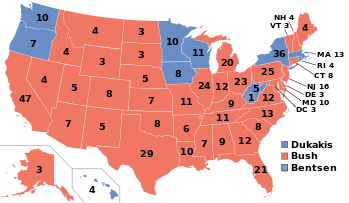United States presidential election in Illinois, 1988
| | ||||||||||||||||||||||||||||||||
| ||||||||||||||||||||||||||||||||
| ||||||||||||||||||||||||||||||||
|
| ||||||||||||||||||||||||||||||||
| County Results
Dukakis—70-80%
Dukakis—60-70%
Dukakis—50-60%
Bush—50-60%
Bush—60-70%
Bush—70-80% | ||||||||||||||||||||||||||||||||
| ||||||||||||||||||||||||||||||||
The 1988 United States presidential election in Illinois took place on November 8, 1988. All 50 states and the District of Columbia were part of the 1988 United States presidential election. Illinois voters chose 24 electors to the Electoral College, which selected the President and Vice President.
Illinois was won by incumbent United States Vice President George H. W. Bush of Texas, who was running against Massachusetts Governor Michael Dukakis. Bush ran with Indiana Senator Dan Quayle as Vice President, and Dukakis ran with Texas Senator Lloyd Bentsen.
Illinois weighed in for this election as 2% more Democratic than the national average.
Partisan background

The presidential election of 1988 was a very partisan election for Illinois, with more than 99% of the electorate voting for either the Democratic or Republican parties, and only 4 political parties listed as options on the ballot statewide.[1] This presidential election is notable in Illinois because the majority of smaller counties were able to turn the state Republican against Chicago's highly populated Cook County, which voted mainly for Dukakis. This is also a notable election as it is the most recent election (as of 2012) where the state sent Republican electors to the Electoral College.
Republican victory
Bush won the election in the rapidly liberalizing state of Illinois with a narrow 2 point margin. Like the neighboring state of Missouri Bush's performance here was far below that of Reagans just four years earlier. Bush's loss of many down state rual counties combined with Dukakis's stronger than normal performance across much of the state especially in Cook County which houses the Chicago area, made the election results in this state much closer than usual. Bush would be the last Republican candidate to carry the state of Illinois in a Presidential Election. The election results in Illinois are reflective of a nationwide reconsolidation of base for the Republican Party, which took place through the 1980s. Through the passage of some very controversial economic programs, spearheaded by then President Ronald Reagan (called, collectively, "Reaganomics"), the mid-to-late 1980's saw a period of economic growth and stability. The hallmark for Reaganomics was, in part, the wide-scale deregulation of corporate interests, and tax cuts for the wealthy.[2]
Dukakis ran on a notably socially liberal agenda, and advocated for higher economic regulation and environmental protection. Bush, alternatively, ran on a campaign of continuing the social and economic policies of former President Reagan - which gained him much support with social conservatives and people living in rural areas, who largely associated the Republican Party with the economic growth of the 1980s.
Results
| United States presidential election in Illinois, 1988 | |||||
|---|---|---|---|---|---|
| Party | Candidate | Votes | Percentage | Electoral votes | |
| Republican | George H. W. Bush | 2,310,939 | 50.69% | 24 | |
| Democratic | Michael Dukakis | 2,215,940 | 48.60% | 0 | |
| Libertarian | Ron Paul | 14,944 | 0.33% | 0 | |
| New Alliance Party | Lenora Fulani | 10,276 | 0.23% | 0 | |
| Socialist Equality Party | Edward Winn | 7,021 | 0.15% | 0 | |
| Totals | 4,559,120 | 100.0% | 24 | ||
See also
References
- ↑ "Dave Leip's Atlas of U.S. Presidential Elections". Uselectionatlas.org. Retrieved 2013-07-21.
- ↑ "Since 1980s, the Kindest of Tax Cuts for the Rich". The New York Times. 2012-01-18. Retrieved 2013-07-21.
| Elections in Illinois | ||||||||
|---|---|---|---|---|---|---|---|---|
 | ||||||||
|
||||||||
|
||||||||



